Jeff Knox: Alvin Moore の 石/"UFO 破片" の経緯とその正体
要旨
Jeff Knox が
- Alvin Moore の 石/"UFO 破片"
をその発端となる発見から Alvin Moore の主張、そしてその正体にいたる経緯を解説している。
この解説を聴けば、Jeff Knox の調査能力は侮れないと分かるはず。
注目箇所
30:00 この"石"に関する Jacques Vallee の見解は政府による隠蔽。
切り出し静止画

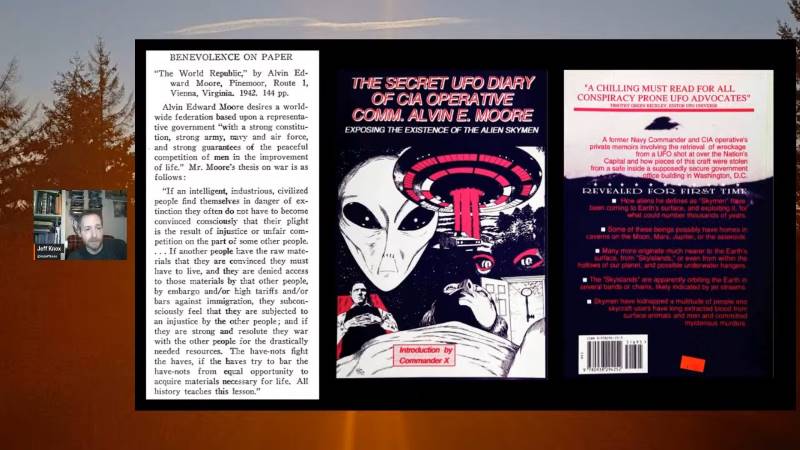
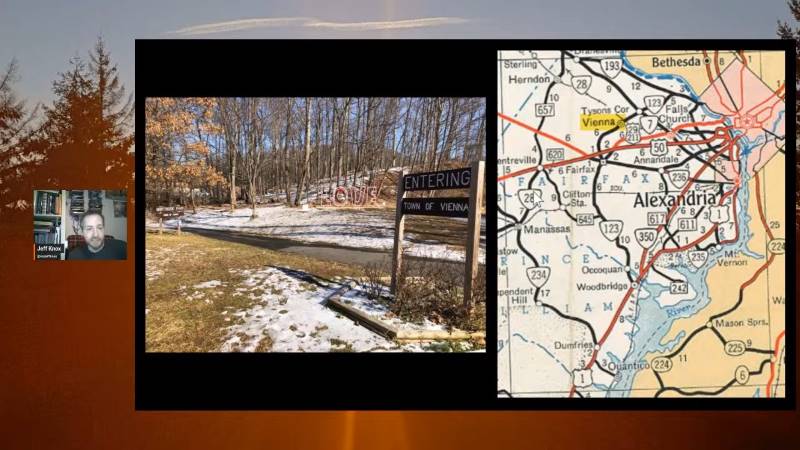
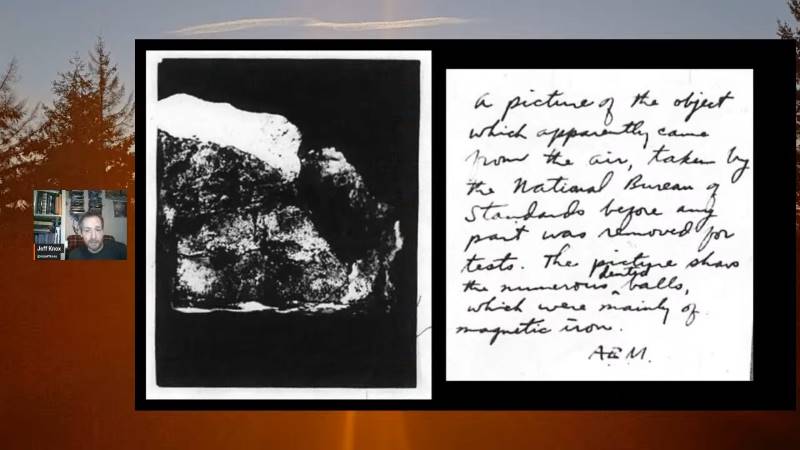
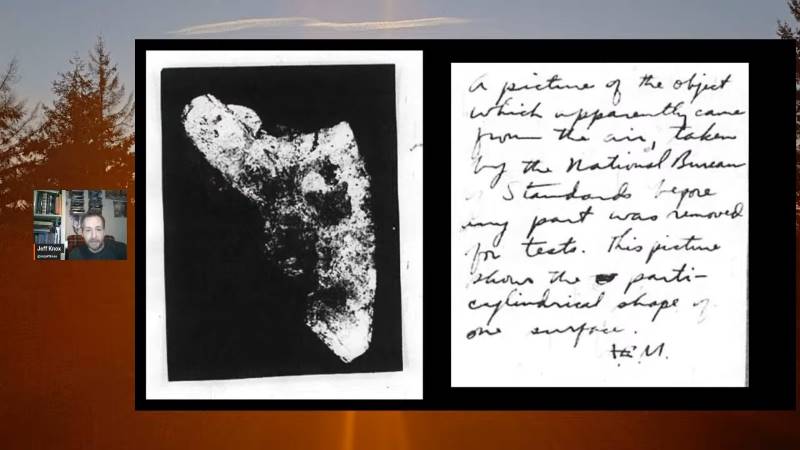

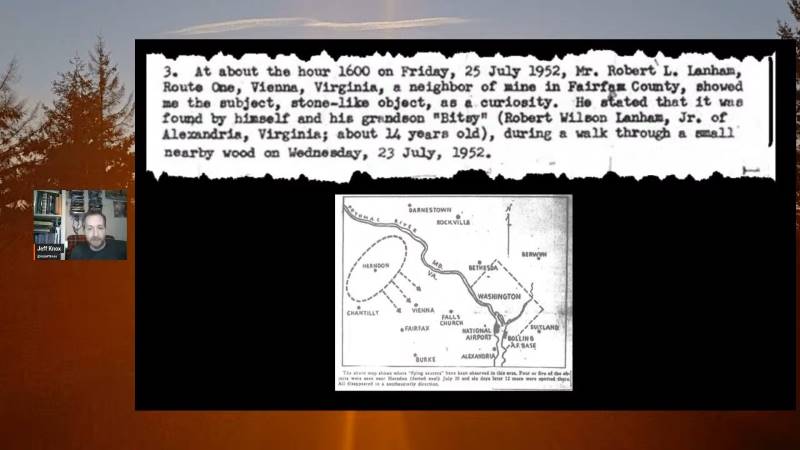
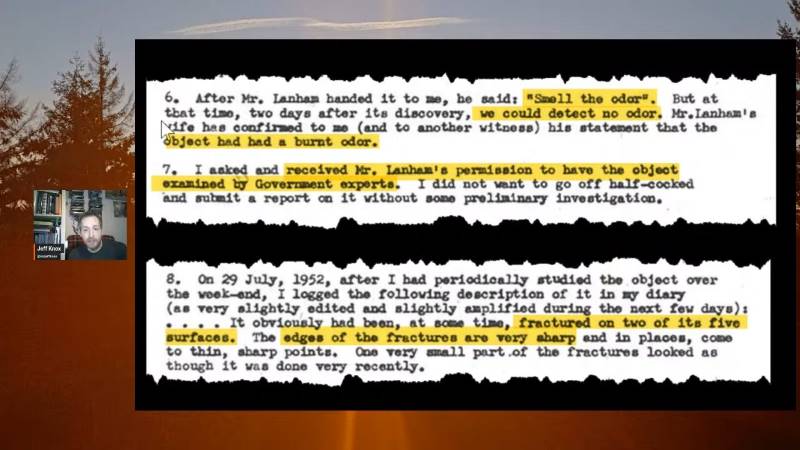
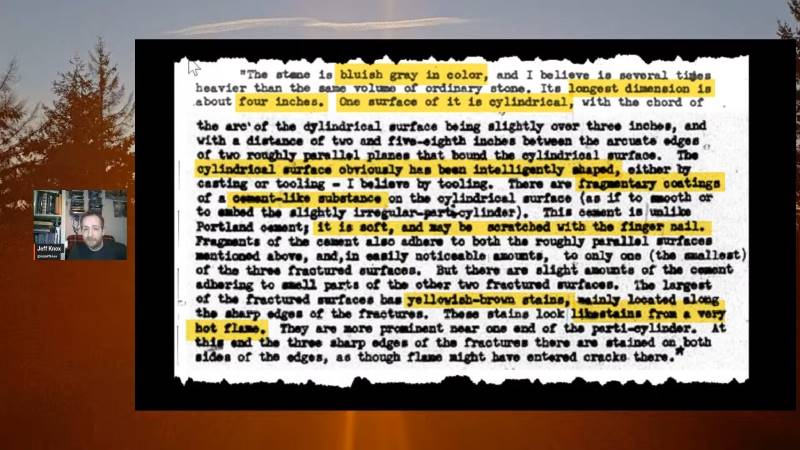
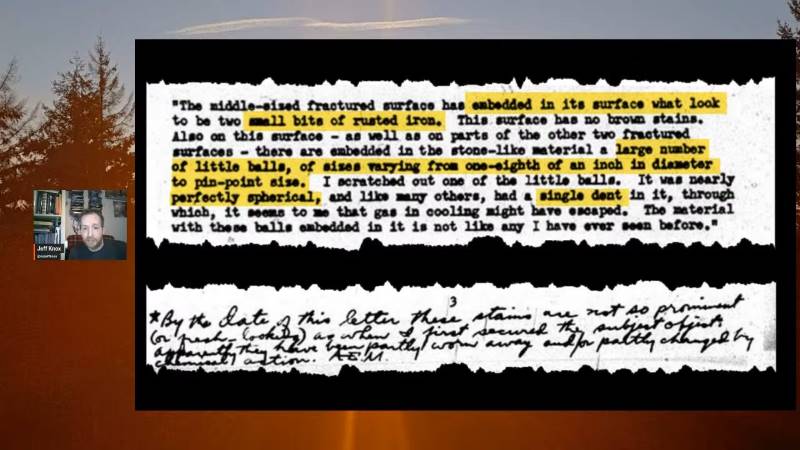
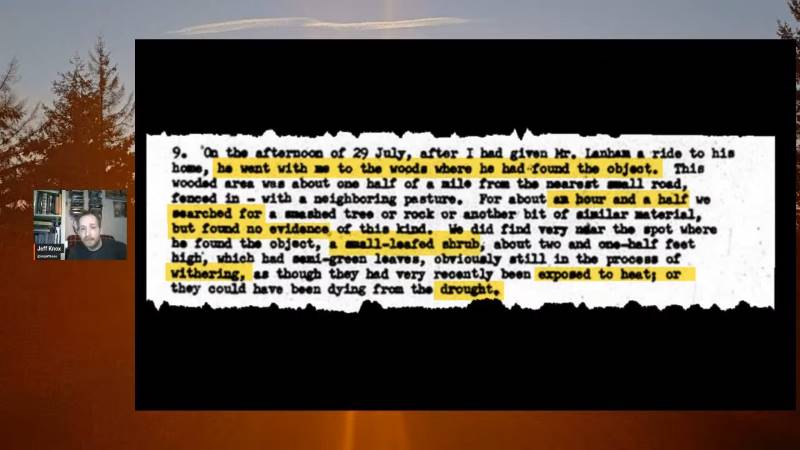
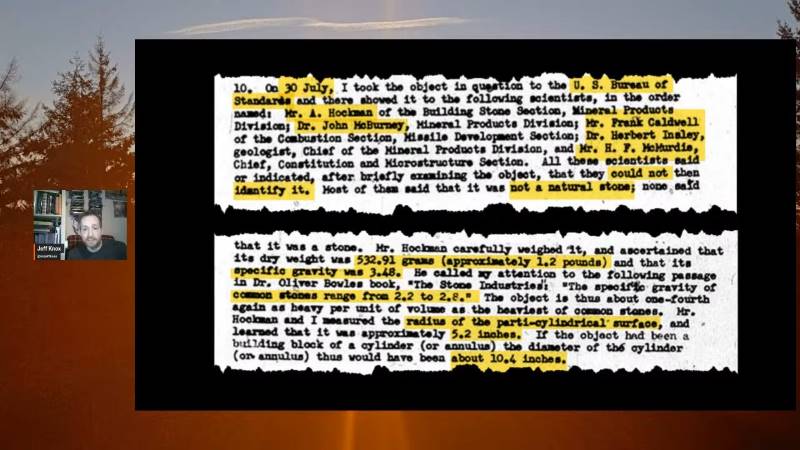
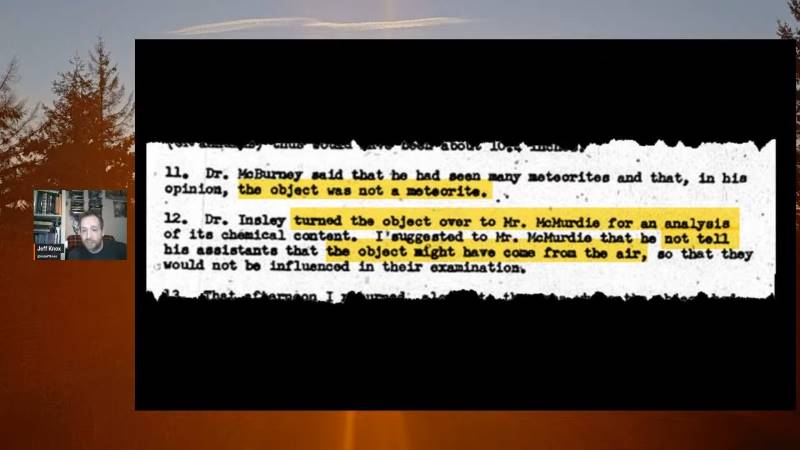
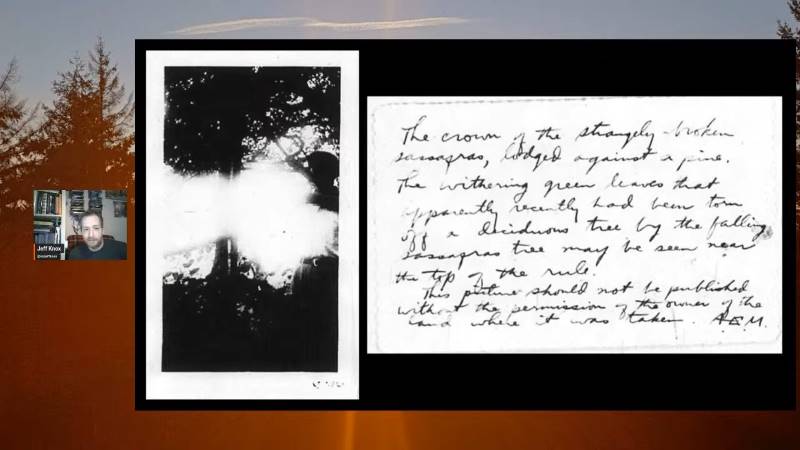
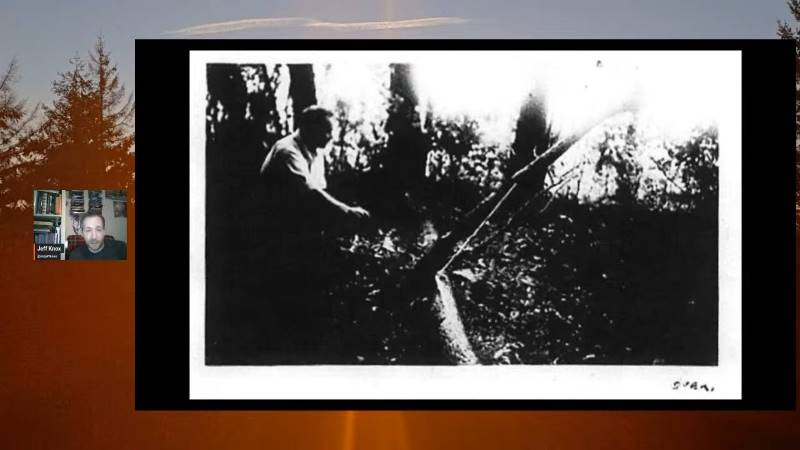
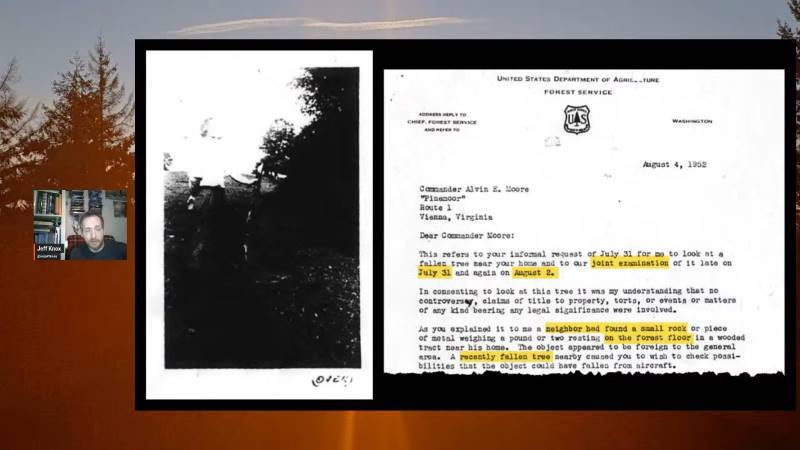
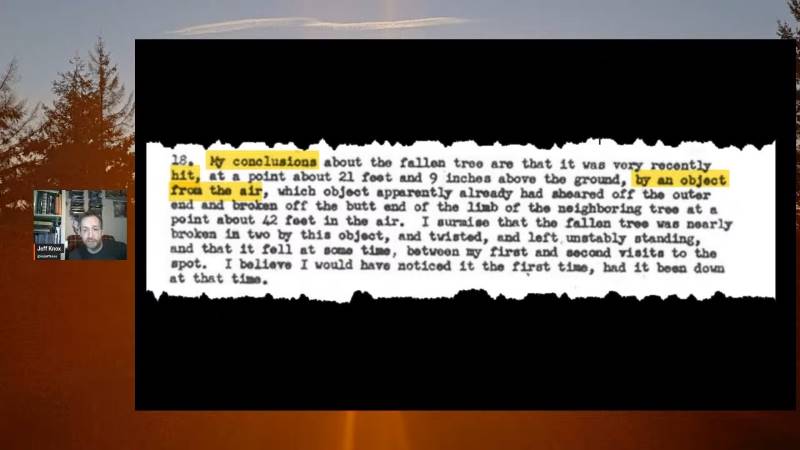
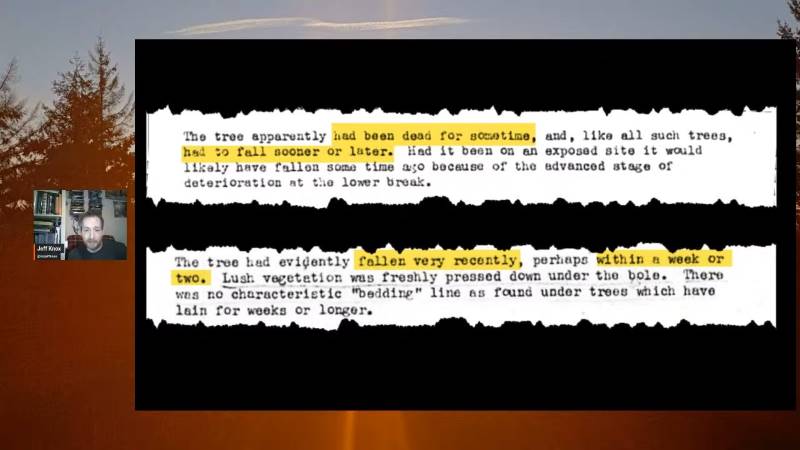
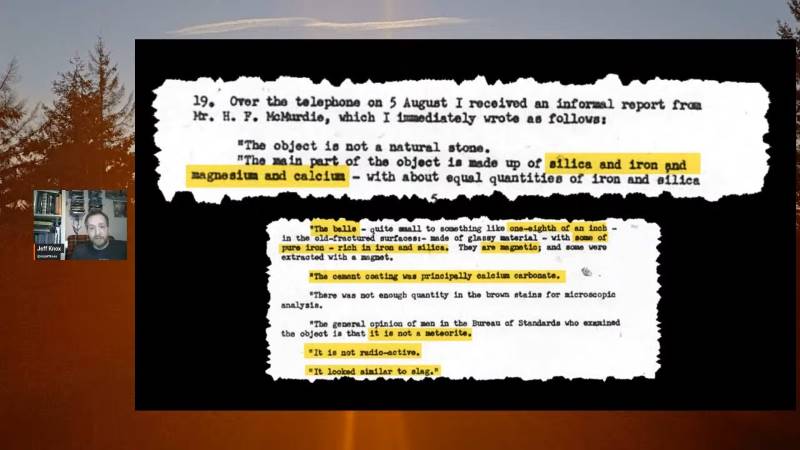
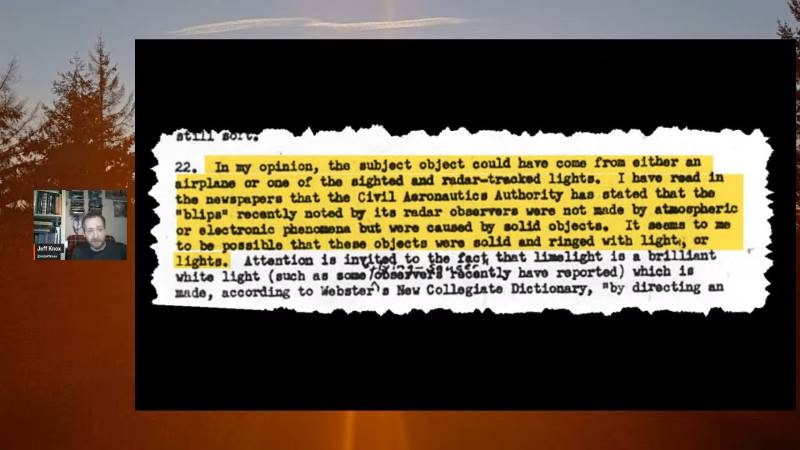
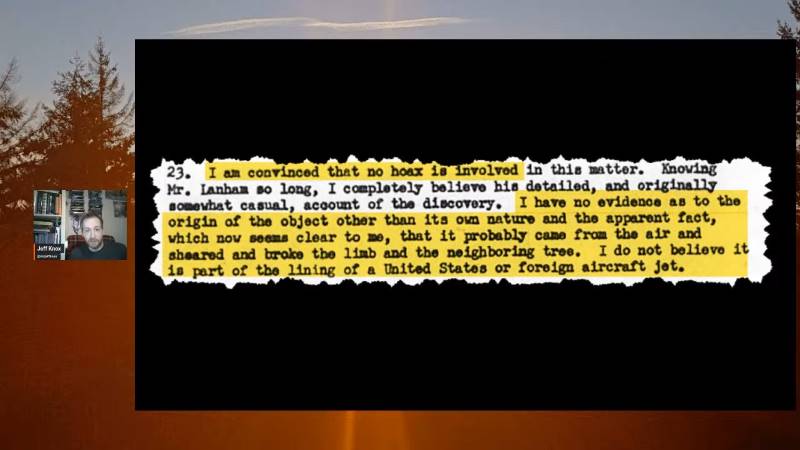
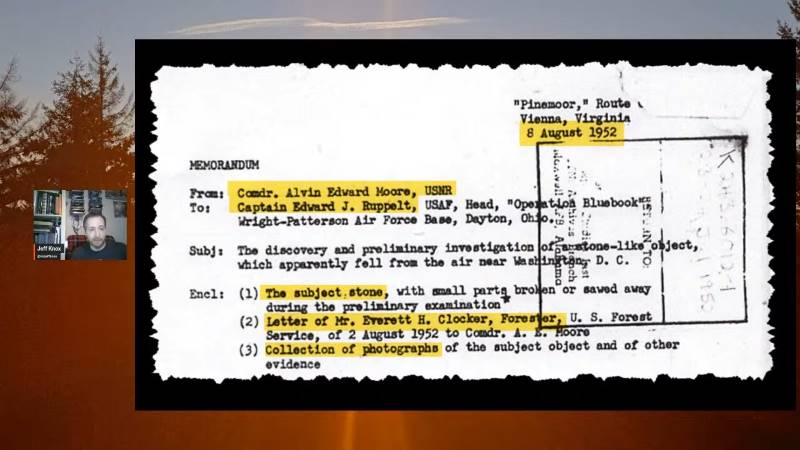
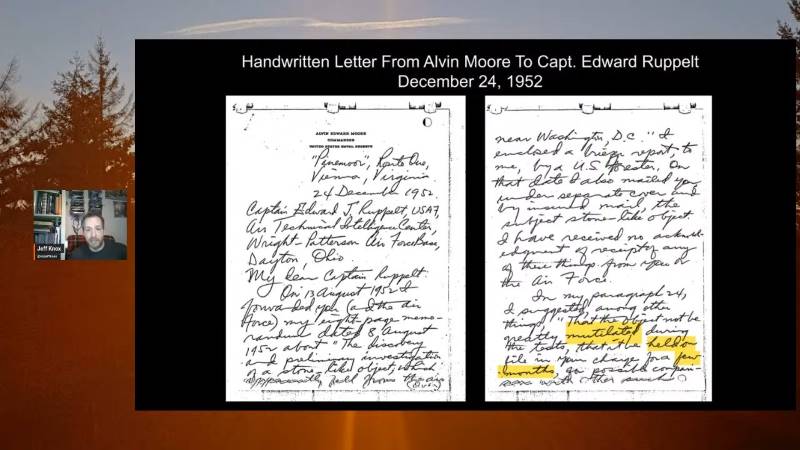
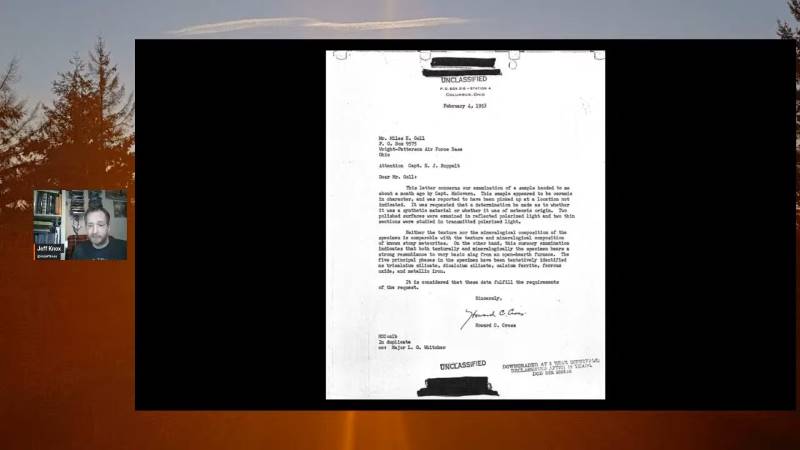
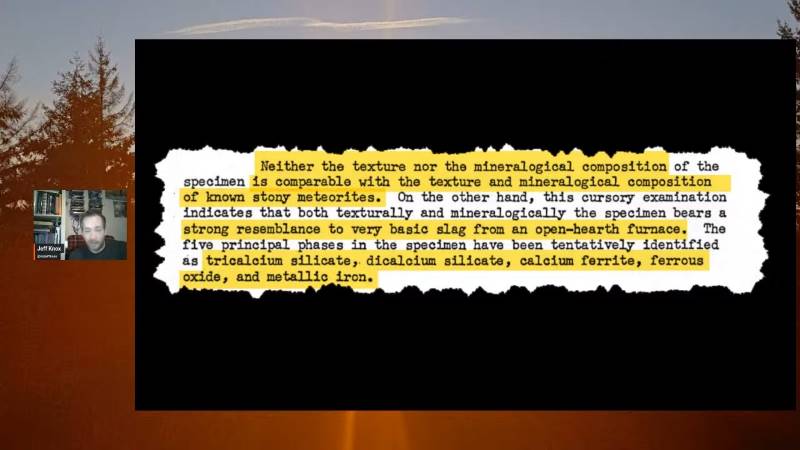
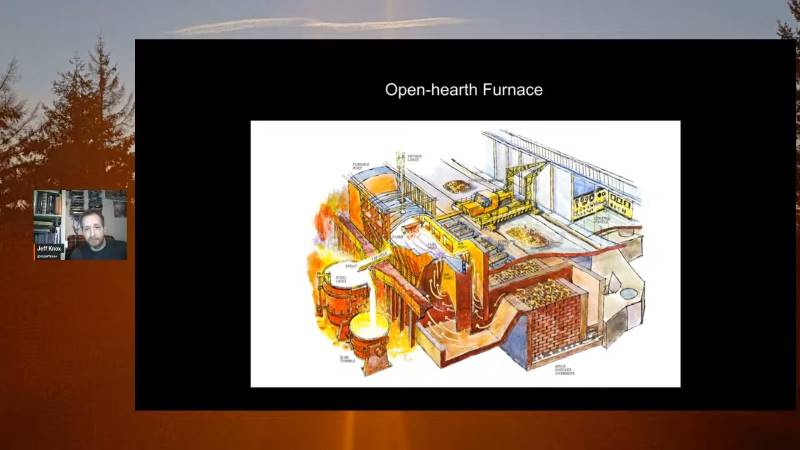
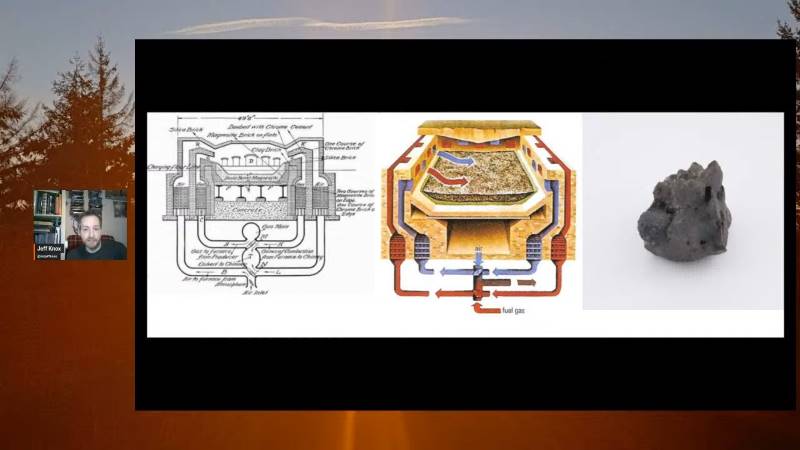

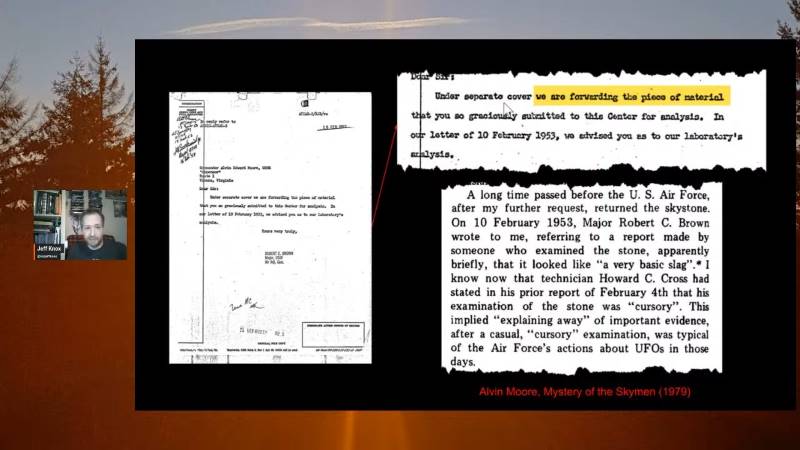
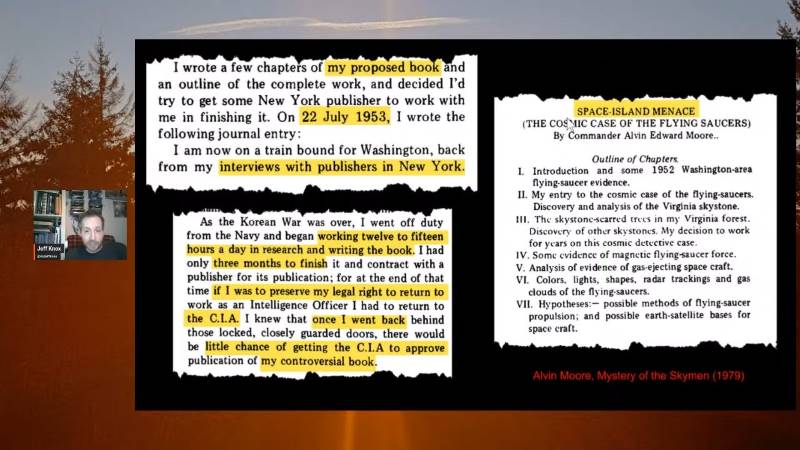

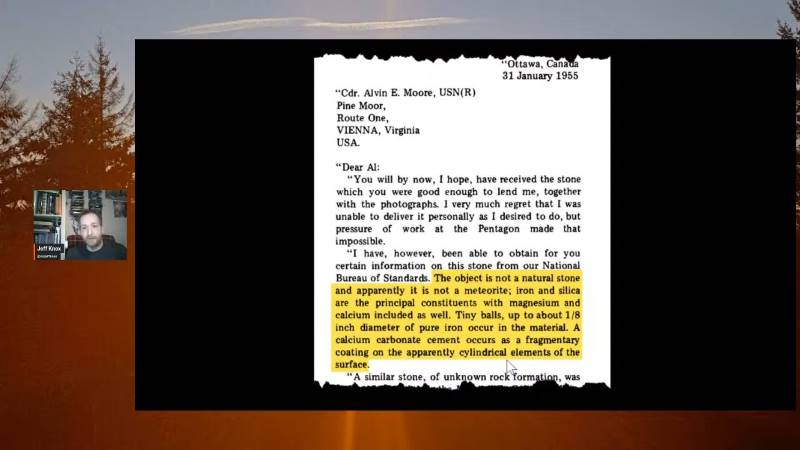
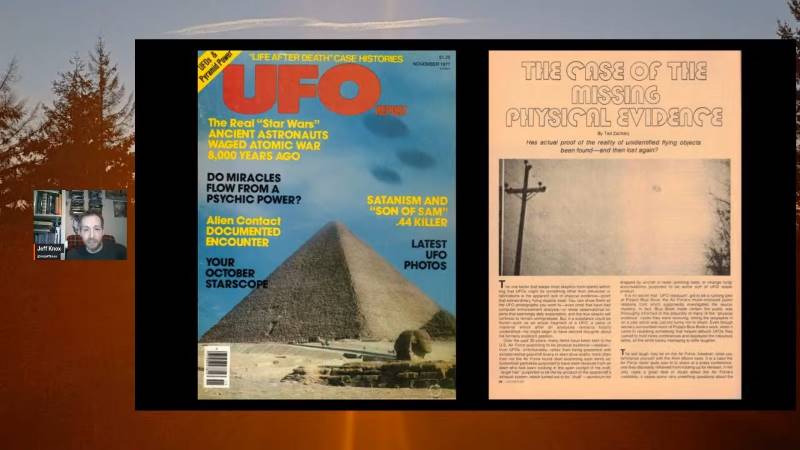
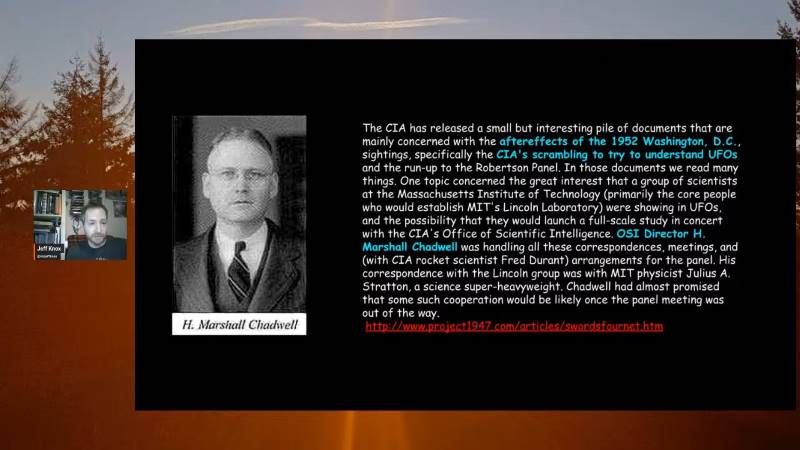
Whisper AI(large-v2 model) + DeepL(2024-07 model)
(offset=10:10)
これは、多くの人が以前に何らかの形で耳にしたことがあるかもしれないが、おそらく本当の話を聞いたことはないだろう。 (00:12:04)
頻繁に語られるストーリーは、UFOロジーの場合と同様に、元の登場人物が完全に取り除かれ、全くほとんど新しい物語が作られるほど歪曲されている。 この偽りの物語は、1960年代にUFOの文献に広まり始め、見逃されていたとはいえ、数人の有名なUFOの人物の協力のおかげで広まった。 そしてこれは、アルビン・ムーアUFOの断片と、それがどのようにしてウィルバート・スミス撃墜の物語に変わっていったかという話である。 (00:12:28)
さて、アルビン・ムーアについての背景情報を少し。 アルビン・ムーア中佐は非常に興味深い人物だった。 彼はかなり印象的な経歴を持っていた。 そのため、この話題について語る証人や人物の中では、より信頼性が高く、信用できる人物の一人だと思われる。 米国海軍兵学校、アメリカン大学、ジョージ・ワシントン・スクール・オブ・ロー、フロリダ大学、ルイジアナ州立大学で教育を受け、学士号と修士号を取得した。 (00:12:56)
博士号まであと一歩というところだったが、政府での仕事が忙しすぎて取得できなかったようだ。 彼は航空工学が専門で、アラバマ州ハンツビルにあったウェルナー・フォン・ブラウンのチームの特許技術者兼弁護士だった。 彼はまた、1920年代半ばにアリゾナとメキシコの国境沿いで結成されたばかりの国境警備隊で国境警備隊員として短期間働いた。 そして彼はそこでの経験について『ボーダー・パトロール』という本を書いた。 (00:13:29)
彼は一時期、確かメキシコの副顧問弁護士を務めていたこともあったし、キャリアの大部分はOSIとCIAの情報将校だった。 特許審査官であったことに加え、航空学と推進特許を専門とし、50以上の特許を所有していたと思われる。 50件を見つけることはできなかったが、いくつか見つけた。アルヴィン・ムーアとかA.E.ムーアとか、違う名前になっているせいもあるかもしれない。アルヴィン・ムーアとかA.E.ムーアとか (00:14:01)
ムーアとか、違う名前になっているせいもあるかもしれない。 しかし、彼は飛行船の設計に関する2つの特許を含む、かなりの数の特許を持っていた。 しかし、その背景には、この男が一見知的な男で、多くの教育を受け、工学的知識も豊富で、CIAと海軍で情報将校のキャリアを積んでいたということがある。 そして彼は基本的に日記をつけていて、後にこの『スカイメンの謎』という本の形で印刷されることになる。 (00:14:32)
そしてその日記は、1997年にティモシー・ベックリーによって「CIA工作員アルビン・E・ムーア司令官の秘密のUFO日記」という別のタイトルで再版された。 彼は1952年にも『世界共和国』という本を書いていて、世界連邦や世界政府のようなものを提唱していた。 彼は非常に興味深い人物だ。 世界連�邦とか世界政府みたいなものを提唱している。 (00:15:00)
しかし本題に入ると、1952年7月23日、69歳のロバート・L・ランハムと14歳の孫、ビッツィー・ロバート・ウィルソン・ランハム・ジュニア が、ワシントンD.C.から20マイルほど離れたジョージア州、つまりバージニア州ウィーンのアルヴィン・ムーアのパイン・ムーア邸近くの森を散歩していた。 (00:15:22)
それから、これらの団地がどこにあるのか、正確に把握するのに時間がかかった。というのも、通りや名前がもう存在しないからだ。 彼の住所は、バージニア州ヴィエナのルート1沿いのパイン・ムーアだった。 ただ、ルート7という意味でなければ、バージニア州ウィーンにルート1など存在しない。 国勢調査のデータによれば、彼は実際にルート7に住んでいたことになる。 (00:15:49)
しかしとにかく、正確な場所を探すのに時間を費やした。 でも本当に重要なのは、バージニア州ウィーンの郊外の森の中だったということだ。 彼らはアルヴィン・ムーアの地所の近くの森の中を歩いていた。 ほとんどの文献によれば、この事件はアルヴィン・ムーアの地所で起こったとされている。 そこで発見されたんだ。 しかし実際はそうではない。
(00:16:14)
文献の中には、実はランハムの人々の土地で起こったと書いてあるものもある。それも実は真実ではない。 知らない隣人の土地にあった。 だから、どこで起きたのか正確にはわからない。 しかし、彼らは最近この地域で殺された母親の子ギツネを探しに森の中を歩いていた。
(00:16:31)
そして彼らは一休みするために立ち止まり、このグラウンドホッグが出てくるのを見ようと見守った。 突然、孫のビッツィーが言った、「おじいちゃん、あの石、変じゃない? そしてランハム氏はビッツィーが行くのを見届け、彼は松葉の上に置かれた石を拾い上げた。地面に埋まっているわけではない。 他の場所で頻繁に報告されているように、穴の中にあるわけでもない。
(00:16:57)
君たちのために硫黄を入れる必要があったんだ。 でも実際はそうではない。 松葉の上で見つかっただけだ。 どの文献にも、温かかったとか、触るとまだ熱かったとかさえ書かれていない。 ただ焦げた臭いがするというだけだ。 ただ、松葉の上に横たわっていただけなんだ。 (00:17:16)
しかし彼はそれが普通の石ではないと感じた。 大きさの割に重すぎた。 それに焦げたような臭いがした。 この写真は、最高の写真ではないが、この物体のそばにある唯一の写真だ。 国立標準局がこの物体を分析したときに撮ったものだ。 裏面のムーアのメモによれば、おそらく物体をテストしたり切り刻んだりする前に撮影されたものだ。 (00:17:42)
だからこれしかない。 しかもそれほど読みやすいものではない。 あまりよく見えない。 しかし、とにかく彼らが発見した石を見れば、その石がどのようなものかがわかるだろう。 さて、2日後の7月25日午後4時、 ランダム氏は隣人であり、ここ4、5年の上司でもあるアルヴィン・ムーア中佐の車で家まで送ってもらうことになった。 (00:18:09)
つまり、ランダム氏は基本的に管理人のようなもので、この数年間、彼の土地の周りの仕事をしていたのだ。 (00:18:15)
そしてムーアは結局、彼と時には彼の孫を、彼の土地から自分の家か孫の家まで送っていくことになる。 この時もそうしていた。 彼はランダム氏を別の男と一緒に家まで送っていた。 そしてランダム氏はムーアにこの不思議な石のことを話し、孫が森で見つけたこの石のサンプルを見せようと申し出た。 (00:18:37)
彼は最初、隕石かもしれないと思い、自分が見つけたこの不思議な石について意見を求めていた。 ムーアはランダムに、空飛ぶ円盤の新聞記事について話した。ちょうど19日と20日にワシントンで起きた騒動の数日後だったからだ。 しかし、ムーア、ランドハムは基本的にその話を追っていなかった。 彼はその話を聞いたことがなかったし、空飛ぶ円盤の話にはまったく興味がないようだった。 (00:19:02)
しかしムーアは、この物体がワシントンD.C.とヴァージニア州ハーンドンを結ぶ道の下で発見されたことに気づき、魅了された。 レーダーオペレーターやベテランパイロットが、空飛ぶ円盤や光る物体を目撃したとされる場所だ。 それで彼はこの物体に非常に興味を持ち、そこに何か関係があるのではないかと考えた。 (00:19:29)
その物体をよく調べてみると、最初に発見されたときにあった焦げた臭いはもうしない。 ムーアはランドハムの許可を得て、その石を政府に調べてもらう。 この時点で、ムーアは航空局の技術情報部門のチーフとして働いていた。 航空局というのは、最初ちょっとわからなかったので調べてみた。 (00:19:56)
NASAや初期のNASAとは関係ない。 航空局はアメリカ海軍の物資支援組織だった。 1921年から1959年まで海軍航空を担当していた。 海軍航空機と関連システムの設計、調達、サポートを担当していた。 彼はそこの技術情報部門のチーフだった。 彼はこの物体を分析のために送りたかったのだが、自分で予備調査もせずに中途半端な状態で送り出したくなかったようだ。 (00:20:25)
何がわかるか試してみたかったのだ。 そして7月29日、その前の週末にその石を定期的に調査した後、彼は日記に次のような説明を記録した。 この石は明らかに、ある時点で2つの面が割れていた。 割れ目の縁は非常に鋭く、ところどころにこのような尖った部分がある。 骨折のごく一部は最近できたように見えた。 (00:20:56)
石の色は青みがかった灰色で、普通の石の同じ体積より数倍重いと思う。 長さは4インチほどである。 表面は円筒形で、芯から円筒面の弧までが3インチ強である。 (00:21:12)
そして円弧と円弧の間の距離は2.5八インチである。 円筒形の表面は、鋳造か金型加工によって、明らかに巧妙に形作られている。 円筒形の表面にはセメントのような物質の破片がある。 最も大きな破断面には、主に破断面の鋭角に沿って、黄色がかった、あるいは褐色の汚れがある。 これらの汚れは、非常に高温の炎による汚れのように見える。 (00:21:36)
また、この表面にも、他の2つの破砕面の一部にも、石のような物質の中に、直径8分の1インチからピンポイントの大きさまで様々な大きさの小さな球が多数埋め込まれている。 なお、8月8日にルペルトに送られたこの手紙の時点では、シミはもうあまり目立たなくなっていた。 そしてその日の夕方、ムーアはランサムに同行して、この物体が発見された森の一帯を訪れた。 (00:22:07)
そして二人はこの森の一帯を1時間半ほど調べ、木が折れていない��か、あるいはこの物体がそこから来たことを裏付けるような追加の証拠はないかと探した。 しかし、物体が発見された場所の間に、熱にさらされていたのかもしれないが、干ばつで枯れてしまったのかもしれない小さな茂みがあった他には、その時点では特に興味深いものは見つからなかった。 (00:22:29)
7月30日、ムーアはついにこの石のような物体をアメリカ基準局に持っていくことに決め、5人の科学者に見せた。 ほとんどの科学者は、それが自然石ではないと感じた。 そこで、鉱物製品部石材課のジョージ・ホックマンがその石の重量を測定し、乾燥重量が53.9、53. (00:22:53)
すみません、532.91グラム、およそ1.2ポンド、比重は3.48で、一般的な石の比重の範囲から大きく外れていると判断した。彼らが参照した本によると、その範囲は2.2~2.8しかなかった。 ホックマンとムーアは、円筒形の表面の半径を測定したところ、およそ5.2インチであったことから、もし物体が円柱から生まれたものであれば、半径はおよそ10.4インチであっただろうと推定している。 (00:23:22)
他のところでは、彼は2フィートに近かったと思う。後に他の人たちも、このサンプルについて2フィートに近いと言うだろう。 さて、彼がこのサンプルを見せた人の一人に、鉱物製品部門のジョン・マクバーニー博士がいる。 彼はこれまで多くの隕石を調べてきたが、これは隕石ではないと言った。 この物体は最終的にH.F.マクマーディ氏に引き渡された。 (00:23:48)
H.F.マクマーディ氏(憲法・微細構造課長)は、さらなる分析のために引き渡された。 そしてムーアは、結果が偏らないように、助手の誰にも物体がどこから来たかを教えないことを提案している。 というのも、後になって多くの人が、分析者がその物体がどこから来たのか知らされていなかったという事実を問題にするからである。 (00:24:14)
しかし実際のところ、彼らはムーア自身から物体の出所を言わないように提案されたのであり、率直に言って、物体の化学分析を行うのに物体の出所を知る必要はない。 (00:24:25)
だから覚えておいてほしい。 だから、彼らはその物体が空気から来たとは言わない。 その日の夕方、ムーアは物体が発見された場所に戻ることにし、さらに1時間半かけて、他の証拠を見つけることができないか、前回の訪問でチェックしなかった場所をチェックすることにした。 (00:24:47)
森と木々の写真が3枚ある。 石の写真よりもっとひどい。 ほとんど載せなかったが、載せた。 そしてこの捜索中、彼は物体があった場所からおよそ45フィート離れた場所に、この物体が発見された方向を向いている、折れて倒れたサッサフラスの枯れ木を見つけた。 翌日、彼はアメリカ森林局に電話し、森林管理官であるエバーハゲ・クロッカー氏と連絡を取った。 (00:25:20)
そして彼はその日のうちに、そして8月2日にも現場を調査しにやってきた。 そしてムーアは、彼と一緒に現場に行って調査した結果、ある結論に達した。 そして彼は倒れた木についてこう言った。 それはごく最近、地上21フィート9インチの地点で、上空からの物体に衝突されたもので、どうやら外縁を剪断し、上空42フィートの地点で隣の木の枝の先端を折ったようだ。 (00:25:54)
倒れた木はこの物体によって二つに折れそうになったのだろう。 さ�て、残念なことに、専門家である森林局のクロッカー氏は、この木の損傷について同じようには考えていない。 彼は、この木はどうやら枯れてからしばらく経っているようだと言う。 このような木はすべてそうであるように、遅かれ早かれ倒れなければならなかった。 そして、明らかにこの木はごく最近、おそらくここ1、2週間のうちに倒れたのだろうと付け加えるしかない。 (00:26:21)
その数日後、彼は8月5日に電話を受け、 、ミッチェル氏、第8回憲法微細構造部門のジェフ・マクマーディ氏から、分析のために石を渡されたという非公式の報告を受けた。 そして彼はこの石について、またこの電話から次のようなメモを記録した。 この石は自然石ではない。 物体の主要部分はシリカと鉄とマグネシウムとカルシウムで構成されており、鉄とシリカは同量であった。 (00:26:57)
玉は、古い破砕面では8分の1インチのようなかなり小さなもので、鉄とシリカに富んだ純鉄もあるガラス質の物質でできている。 それらは磁性を持ち、一部は磁石で抽出される。 セメントの被膜は主に炭酸カルシウムだった。 この物体を調査した基準局員の一般的な意見は、これは隕石ではないというものだった。 (00:27:18)
放射性物質ではない。重要なことなので引用するが、スラグに似ている。 (00:27:24)
だからムーア、実はこれにはがっかりしたんじゃないかと思うかもしれない。 しかし実際には、彼はこの結果にある種の高揚感と満足感を覚えている。 彼が見つけたのはただの自然石ではないし、隕石でもない。 (00:27:51)
そしてムーアにとって、答えは明らかだった。 ワシントン・ナショ�ナル・サイディングの上空を飛んでいた光る物体の一つが、何らかの理由でこの破片を放出したに違いない。 おそらく、ジェット機との衝突で飛び散ったか、あるいはこの船が機能するための自然なプロセスだったのだろう。 しかし彼は、この石は空から飛んできたに違いないと確信していた。 (00:28:14)
そして、これらの物体が目撃された経路にあったので、彼はそれがこれらの物体の一つから来たに違いないと確信した。 彼は、それがアメリカ国内または外国の航空機から来たものだとは考えなかった。 そして、これらの結果と石についての予備的な調査に満足した彼は、ついに結果を送って政府にさらに調べてもらうことにした。 (00:28:36)
そして彼はさらなる調査のため、サンプルを空軍のプロジェクト・ブルーブックに送った。 そして1952年8月13日、彼は石を送った。 彼はこの8ページの回収報告書を送った。 ここまでの引用のほとんどは、彼がルペルトに書いたこの8ページの報告書からのものである。 そして彼はこの手紙の中で、木の落下についてクロッカーに送った森を数ページにわたって送っている。 (00:29:02)
彼は石の写真3枚と、倒木の写真3枚を追加して送った。 そして彼は、オハイオ州デイトンのライト・パターソン空軍基地にいるブルーブックの指揮官、エドワード・ルペルト大尉にそれらをすべて送った。 12月24日、少し苛立ったアルビン・ムーアは、ルペルト宛に再び4ページの手書きの手紙を書き、自分の石の分析について空軍から何の返事もないことに不快感を示した。 (00:29:36)
彼は、自分のサンプルをあまりひどく傷つけないように空軍に頼んだことを繰り返している。 そして、もし他のUFOの残骸やハードウェアが入ってきたら、比較分析ができるように、数カ月間保管した後、要求通り、彼に送り返すべきだと言った。 それで彼はルペルトに自分のファイルをチェックして、石を返してくれるように頼んだ。 (00:29:58)
さて、12月のムーアの手紙によって行動に駆り立てられたのか、1953年1月の初め、空軍はムーアのサンプルをオハイオ州デイトンに送ることになる。 バテル記念研究所のハワード・C・クロスにである。 (00:30:15)
さて、この件に関するいくつかの話では、このクロスという人物は研究所の技術者のようなもので、オハイオ州立大学やバテルで働いたのか、どこで働いているのかは不明だと述べられている。 しかし、ハワード・クロスはUFO界ではかなり悪名高い人物であることがわかった。 彼はかなり興味深い人物だ。 彼はおそらく、UFO学者で陰謀論者のジャック・ヴァレによって広められた悪名高い1953年のペンタクルメモの著者として最もよく知られている。 (00:30:50)
そしてヴァレは基本的に、この記事には隠蔽工作があり、人々が知らない秘密のUFOプロジェクトが進行していたと解釈している。 UFOの目撃をシミュレートすることで、人々がどのようにUFOを報告するのかを把握することができる。 ただ、隠蔽工作はなかった。秘密のUFO計画はなかった。 (00:31:14)
まあ、それはある種の秘密だった。それはバテル特別報告書14という統計調査で、彼らがやっていたんだ。 それ以外の秘密は何もなかった。 このメモはジャック・ヴァレによって有名になったが、実際にはごくありふれたものだ。 この書簡が書かれた1��週間かそこら後に開かれるロビンソン・パネルまでに分析を終える時間をくれと、バテル研究所が基本的に懇願しているようなものだ。 (00:31:40)
つまり、陰謀論的な感覚はすべてナンセンスだったのだ。 しかし、彼はおそらくあの手紙で最も有名だろう。 ロズウェルの金属メモリの分析に携わったと言われているからだ。 彼はバテルのチタン専門家だった。 チタンの研究の多くはニチノールの成分であり、それは実際に記憶金属であり、陰謀論者の中にはロズウェルの墜落事故から来たと信じている者もいる。 (00:32:13)
そんなことはない。でも彼はその開発すべてに携わっていた。 とても興味深く、とても賢い人物だが、この原作では軽視されている。 彼はバテル社のハワード・クロス博士なんだ。 彼は基本的にこの金属を分析する。 彼はざっとした検査をする。 多くの研究者は、このざっとした検査について陰謀論的になる。 彼らは基本的に、それは彼らがそれを否定したという合言葉だと言う。 (00:32:45)
彼らはそれを見ていない。ざっと調べただけで、デタラメを発表しただけだ。 そんなの、実際には意味がないんだ。 ざっと調べたというのは、そういう意味ではない。 彼が行ったのは、この物体を透過光と反射偏光の下で観察することだった。 基本的にこの物体を分光していたんだ。 そして彼は2月4日、この簡単な報告書を空軍に提出した。 (00:33:09)
その中で彼は、この試料の質感も鉱物学的組成も、既知の石質隕石の質感や鉱物学的組成に匹敵するものではないという、標準的な科学者である国立科学局の科学者の意見を確認し、隕石学に更なる釘を刺した。 (00:33:26)
クロス氏もまた、この標本が国家標準科学局の科学者が示唆したようにスラグが類似していることを確認している。 彼は詳しく説明する、このざっとした検査は、質感的にも鉱物学的にも、この標本が平炉の非常に基本的なスラグに強く似ていることを示している。 試料の元素組成は、様々な正珪酸塩、カルシウム・フェライト、酸化第一鉄、金属鉄を含んでいる。 オルソケイ酸塩は基本的にケイ素分子である。 (00:33:58)
4つの水素を持ち、Si4マイナスである。 だからケイ酸三カルシウムやケイ酸二カルシウムは、Na2SiO4マイナスのようなオルトケイ酸塩になる。 そんなことは誰も知る必要はない。 とにかく、基本的には一般的な平炉スラグであることは間違いない。 平炉というのは工業炉の一種で、かつては鉄鋼の生産に広く使われていた。 (00:34:28)
今はあまり使われなくなったが、ウクライナはまだかなり広範囲に使っている数少ない国のひとつだろう。 しかし、ほとんどの人は他の方法に移行している。 銑鉄から余分な炭素やその他の不純物を燃やして鉄鋼を生産するのに使われるんだ。 その仕組みは、まず炉に金属スクラップと銑鉄を投入する。 その後、燃焼ガスを使って加熱し、装入物を溶かす。 (00:34:53)
その後、大気中の酸素と酸化鉄を加えて炭素を酸化させ、一酸化炭素を形成させる。 そして不純物が取り除かれ、溶鋼が形成される。 不純物を除去するために、石灰岩のようなスラグ形成剤(炭酸カルシウムなど)が加えられる。 そしてスラグは、一般的にはこの大きな取鍋を使ってスラグシンブルにすくい取られる。 (00:35:21)
この余分なスラグ��はその後、廃棄物として砂溜めに捨てられ、冷却される。 つまり、シリカは砂採取場から得られることになる。 この製法は、現代では高炉や電気アーク炉を使った基本的な酸素製鉄に取って代わられている。 それでも基本的には同じプロセスだ。 溶鋼はスラグの層の下の底に形成される。 (00:35:49)
スラグ層は溶鋼を酸化などから守る役割も果たす。 そして溶けた鉄を底から叩き落とし、スラグを上からすくい取る。 そしてこれらの炉は、現在でも基本的な酸素製鉄による近代的な製鉄方法においても、基本的には炉を使用している。 ただ取鍋にパイプを通して酸素を導入し、酸素を供給しながら製鋼する。 (00:36:16)
そして容器の加熱には電気アーク炉のようなものを使う。 しかし、溶けた鋼鉄が底から出て、スラグを上からすくい取るという基本的には同じプロセスであることに変わりはない。 今では一般的に取って代わられているが、これらの炉は前世紀前半にはかなり普及していた。 バージニア州でもかなり人気があった。 (00:36:42)
そして実際に、あらゆる曖昧な場所でスラグを見つけることは珍しいことではなかった。 (00:36:47)
このスラグは結局、建設や道路工事で商業的に使われることになる。 この画像では、スラグが使われているシンブルを見ることができる。 スラグは上からすくい取られて、この小さな丸いシンブルに入れられる。 このシンブルのエッジの位置と一致するかもしれない。 (00:37:10)
そしてこのシンブルはそれを砂の穴に捨てる。 そして小さな石を集めて、道路建設やその他の建設プロジェクトに使うんだ。 だから、いろんな場所でこ�のようなものを見つけることができる。 UFO研究家のマイケル・ソードは、私がこの研究の一部を利用していると言った。
(00:37:37)
彼が子供の頃、ウェストバージニア州を探検して見つけたものとほとんど同じに見える。 つまり、この物体は基本的に、どこから見ても、スラグ炉から出たものと同じだったのだ。 トッド・ゼッケルという研究者はこの事件についての論文を書いているが、彼らはスラグ説がいかに成り立たないかを大々的に論じている。 (00:38:06)
なぜなら、その物体は木々の間を何かが通り抜けた結果だからだ。 では、空気中から入ってきたものがスラグであるはずがない。 繰り返すが、問題なのは、彼らはその証拠を何一つ持っていないということだ。 私たちが知っているように、木は実際には腐っていて、サンプルとは何の関係もない。 サンプルは地面に落ちていた。 (00:38:24)
炉からどうやってそこにたどり着いたかは説明できないが、空気中から来たと信じる理由はない。 彼らはまた、クロスはその物体がどこから来たのか知らされていなかったと、陰謀論的な発言もしている。 それでどうやって分析したんだ? しかし今指摘したように、ムーアは結果を偏らせないために、物体がどこから来たのか言わないようにと実際に人々に言ったのだ。 (00:38:49)
しかしその後、彼は陰謀論的になって、言われなかったから正しい答えにたどり着けなかったかのように振舞う。 ゼッケルもまた、彼らはムーアの証人としての高い資質と地位、そして信頼性を考慮しなかったと言い続けている。 しかし、その唯一の問題は、ムーアは何の証人でもなかったということだ。 (00:39:11)
彼は物体を見つけもしなかった。彼は第三者のようなものだ。 だから、率直に言って、彼の信頼性はこの状況とは何の関係もない。 とにかく、6日後の2月10日、ロバート・ブラウン空軍少佐はムーアのルペルトへの手書きの手紙に返事を出した。 (00:39:30)
そして彼はムーアに、彼の手紙が誤配されたと説明した。 そしてそれが、彼の最初の報告に対する返答が遅れた原因のようなものであった。 彼は続けて、クロス博士の2月4日の報告書をそのまま引用し、文字的にも鉱物学的にも、この標本はオーク炉と炉床炉の非常に基本的なスラグに酷似している、と述べた。 空軍は来週中に報告書を、来週中に標本を返却すると約束している。 (00:39:55)
そして2月16日、彼らはムーアにサンプルを郵送した。 ムーアによれば、サンプルが返送されたのは来年の半ば、1954年の半ばであった。 しかし、空軍からの情報では、1953年2月16日に返送されたことになっている。 そしてゼッケルは、ムーアからの再三のサンプル返却要求の後、初めて郵送されたと言うだろう。 (00:40:23)
おそらくムーアが1952年12月に書いた手書きの手紙のことだと思う。 ムーアと空軍の間に、このサンプルに関する、あるいはサンプルを取り戻そうとする他のやりとりがあった形跡はない。 そして、彼らはそれを郵送で送り返すとすぐに返答した。 だから、おそらくそれは、他の場所で間違っている細部に過ぎないと思う。 1953年の初め、CIAを辞めたムーアは、しばらくCIAで働いていた。 (00:40:50)
彼は朝鮮戦争のために現役復帰するために去った。 そして1953年初め、彼は現役を退く。 ナバホ予備��軍に入り、CIAに戻ろうとした。 というのも、彼にはCIAに戻る権利を行使しなければならない期間があったのだろう。 それを行使しなければ、復帰できないとかなんとか。 (00:41:08)
それで彼はCIAに戻りたがった。 でもその前に、彼は短いサバティカル(休暇)を取って、そのノートをもとに書こうと思っていたUFO本の原稿を仕上げようとしたんだ。 基本的には、彼がつけていた日記だ。 当初、この本のタイトルは『宇宙島の脅威』となるはずだった。 彼はCIAに戻った後、この本を出版することはできないだろうと思った。 (00:41:31)
出版の承認を得ることはできないだろう。 だから彼はDOPSERの承認を心配していたんだ。 だから、彼は帰国する前に出版しようとした。 残念ながら、彼は自分の本を印刷したいと思う出版社を見つけるのに苦労した。 彼は1953年7月、出版社との交渉に時間を費やした。 (00:41:52)
彼はキョウの出版社であるヘンリー・ホルトと話したと思う。 そしてトゥルーとも話した。 そして、この本の出版に最も興味を持っていた出版社とも話をした。 でも、その出版社はほとんど教科書の出版社だった。 その出版社は、彼の本は少し思弁的で突飛すぎていて、教科書出版ビジネスの信頼性を損なうと感じたようだ。 (00:42:09)
それで彼らは手を引いた。 だから、彼は自分のUFO本を出版したい人を見つけることができなかった。 その理由はわかる。 その半分を読んだだけでも、かなり荒唐無稽だ。 結局、彼はこの計画を中止し、CIAでフルタイムで働くことにした。 彼は10月に戻り、CIAに戻る権利を行使した。 (00:42:31)
彼らは基本的に、彼が復帰したら�もう仕事を休むことは許さないと言う。 だから準備したほうがいい。 事務処理の問題で、彼が実際にCIAに復帰できたのは1954年の初めだった。 しかし1954年、ムーアはCIAの科学情報部に採用され、空軍から得たこの発見物を再び手にしていた。 (00:42:55)
そしてCIA本部で働いている間に、彼はカナダ陸軍情報部のドナルド・グッドスピード大尉と親しくなり、彼は連絡役としてCIAに所属していた。 そして、UFOとムーアのバージニア・スカイストーンに興味を示したので、ムーアは1954年8月6日に、この男をこのパイン・ムーアの地所に招待することにし、そこで彼らは夜を過ごし、彼のUFO理論と、この見込みのある政府のブルーブックとカナダのプロジェクト・マグネットのUFOプロジェクト、そしてムーアのバージニア・スカイストーンについて話し合った。 (00:43:27)
そしてこの会合で、ムーアはグッドスピードにシリンダーサンプルを贈り、カナダに持ち帰って彼らのプロジェクト科学者に分析してもらうことにした。 ムーアは、カナダのプロジェクトはアメリカのプロジェクトよりも分析においてオープンマインドであるかもしれないと感じていた。 さらに彼は、妻が自宅の前庭で採取したゼラチン状の塊もグッドスピードに渡した。 そしてこのことが、後の彼の空、空の石、空の島、空の化学物質に関する理論のいくつかにつながっていく。 (00:43:55)
それについては後で少し触れるかもしれないが、それで船長はこの物質をカナダに持ち帰って分析できるようにホイルで包んだ。 しかしカナダで開封する頃には、このゼラチン状の塊はクモの巣のような物質に変化していた。 基本的には、天使の髪の毛のようなケースで、ほとんど溶けてなくなるようなものだ。 (00:44:16)
そして、研究者テッド・ゼッケルへの手紙の中で、グッドスピードは、分析のためにカナダのUFOプロジェクト磁石の元責任者ウィルバート・スミスに直接サンプルを渡したと信じていると報告している。 さて、このサンプルがスミスやカナダのUFOプロジェクトに保管されていたときに何が起こったのか、私たちはほとんど知らない。 私たちが知っているのは、プロジェクトによる検査の後、A.V.Roe社によって検査されたということである。 (00:44:47)
少なくともアート・ルンダール(Art Lundahl)によると、彼らはその材料に興味があったようだ。 彼がその主張をどこから得たのか、私たちにはよくわからない。 (00:45:01)
しかし、アート・ルンダールによれば、とにかくアブロ・プロジェクトは興味を持ち、サンプルを分析した。 しかし、サンプルがムーアに返却されたのは1954年の終わりであった。 ムーアからサンプルを受け取ったのは8月6日だった。 だから、カナダ政府の管理下にあった期間はそれほど長くない。 グッドスピード大尉は個人的にサンプルを返すことができなかった。 (00:45:29)
宅配便で送り返すしかなかった。 しかし彼は1955年1月31日に手紙を送り、我々の分析ではこの円柱は自然石でも隕石でもないという結論に達したと書いた。 つまり、私たちがまだ知らないことを教えてくれたわけではないのだ。 鉄とシリカが主成分で、マグネシウムとカルシウムも含まれている。 (00:45:55)
純鉄の直径1⁄8インチまでの小さな球が材料の中に存在する。 炭酸カルシウムのセメントは、表面の円筒形の要素に断片的なコーティングとして存在する。 だから、そうかもしれない。つまり、カナダ政府の調査結果は、基本的には、国立標準局(National Bureau of Standards)が決定したものと同じであり、他の誰もがすでに決定したものと同じである。 さて、研究者テッド・ゼッケルによれば、物体がカナダ政府から返却された直後、ムーアはCIAの科学情報部長H・マーシャル・チャドウェル博士にオフィスで声をかけられたという。 (00:46:37)
チャドウェルはこの謎の円柱石のことを聞き、さらなる分析のために貸してもらえないかと頼んできた。 ムーアは、2年前にUFO研究プロジェクトを提案した後、UFOに関しては自分のことは気にするなと言われてショックを受けていたようだが、それでも喜んでこのプロジェクトをチャドウェルに引き渡した。 これはテッド・ゼッケルが書いた記事で、トッド・ゼッケルはテッド・ザカリーというペンネームを使い、1977年11月のサガのUFOレポートに掲載された。 (00:47:10)
実際に自分でスキャンしてみたんだ。 そして約1週間後、チャドウェルはサンプルをメッセンジャーで送ってきた。 さて、チャドウェルは、私が言ったように、科学情報局の局長だったが、UFOトピック、ロビンソン・パネルにも深く関わっていて、MITのリンカーン・グループのような人たちとUFOトピックの研究への関心について対応しようとしていた。 (00:47:44)
だから彼は、UFOプロジェクトを先導するCIAの中心人物の一人だった。 思い起こせば、ロビンソン・パネルは1953年1月に開催された。 さて、おそらくムーアはサンプルを取り戻した後、それをCIAオフィスの金庫に入れた。 2週�間後、ムーアはある書類を取り出すために金庫を訪れ、その物体がなくなっていることに気づいたとされている。 (00:48:09)
ゼッケルは、世界で最も安全な場所の一つであるCIA本部の中にあるCIAオフィスの金庫から、CIAから何かが盗まれるなんてあり得ないと大騒ぎした。 (00:48:22)
ということは、明らかにCIA自身が盗んだということだ。 さて、残念なことに、ムーア氏は別の場所で、その物がCIAの彼のオフィスから紛失したのか、彼の自宅から紛失したのか、実際には覚えていないと述べている。 そして昨晩、私はゼッケルの記事が基本的に彼の友人であるスティーブン・ソイクスによって盗作され、あるいはコピーされ、『Fate』に掲載されたという記事や手紙を見つけた。 (00:48:49)
そしてムーアは1978年にそれを読んで、いくつかの詳細を提供するために返信の手紙を書いた。 私の家で紛失したのだと思う。 ただ、彼は盗まれたと信じている。 彼を監視し、スパイしている黒ずくめの男たち、通称スカイメンに盗まれたと信じている。 (00:49:13)
そして彼らは彼からサンプルを盗んだが、それは彼の家から盗まれたのだ。 だから、雑誌に掲載されているCIAの関与に関する物語の大部分はナンセンスだ。 ゼッケルの記事には、そのことに関するいくつかの詳細が書かれているが、彼がムーア本人と話したことを考えると驚くべきことだが、この事件に関する詳細のほとんどが間違っている。 だから、CIAが作品を盗んだという例は捨てなければならないが、CIAはここでもウィルバート・スミスの話に関与している。 (00:49:45)
▼展開
This is the case many people may have heard in some form before, but they likely have not heard the true story. (00:12:04)
For the story frequently told, as is the case in UFOlogy, is so distorted that the original characters have been completely removed and an entirely mostly new narrative has been created. This false story started to propagate in the UFO literature in the 1960s, thanks with the help of a few famous, if missed, UFO figures. And this is a story of the Alvin Moore UFO fragment and how it got turned into the Wilbert Smith shoot-down story. (00:12:28)
Now, just a little background information on Alvin Moore. Commander Alvin Moore was a very interesting character. He had quite an impressive background. That would seem to make him one of the more reliable and credible kind of like witnesses and people to talk about this topic, you would think. Educated at the U.S. Naval Academy, the American University, George Washington School of Law, University of Florida, and Louisiana State, he held bachelor's and master's degrees. (00:12:56)
He apparently was just shy of a PhD, but was too busy working for the government to finish that. He specialized in aeronautical engineering, and he was a patent engineer and attorney for Wernher von Braun's team at Huntsville, Alabama. He also, he briefly worked as a border patrol agent in the newly formed Border Patrol in the mid-1920s along the Arizona-Mexico border. And he wrote a book called Border Patrol about his experiences there. (00:13:29)
He was briefly the vice counsel for, I believe, Mexico for a while, and was a career, like I say, he was a career intelligence officer with the OSI and the CIA for a large part of his career. In addition to being a patent examiner, specialized in aeronautics and propulsion patents, he also supposedly held over 50 of his own patents. I wasn't able to find 50, but I found several, and part of it might be because they're under different names, like they're under Alvin Moore or A.E. Moore, and so they don't all different names, like they're under Alvin Moore or A.E. (00:14:01)
Moore, and so they don't all show up in the same listing. But he had quite a few patents, including two for an airship design. But, so the background is this guy is a seemingly intelligent guy, lots of education, lots of engineering knowledge, that was a career intelligence officer with the CIA and the Navy. And he basically kept a diary that would be printed in the form of this book, The Mystery of the Skymen, later on. (00:14:32)
And that diary was also reprinted by Timothy Beckley in 1997 under a different title, The Secret UFO Diary of CIA Operative Commander Alvin E. Moore. He actually had also written a book in 1952 called The World Republic, which he kind of advocates for a world federation or kind of like a world government. And so he's quite an interesting guy. He's written on quite a few different kind of topics there. (00:15:00)
But to get to our main story, on July 23rd, 1952, 69 year old Robert L. Lanham and his 14 year old grandson, Bitsy Robert Wilson Lanham Jr. were walking through the woods near Alvin Moore's Pine Moore Estate, 20 miles outside of Washington, D.C. in Vienna, Georgia, I mean, Vienna, Virginia. (00:15:22)
And I'll point out, I spent some time trying to figure out kind of exactly where these estates were. And I had a little difficulty because the streets, the names don't really exist anymore. His address was kind of just Pine Moore on Route 1 in Vienna, Virginia. Only there's never been a Route 1 in Vienna, Virginia, unless he means Route 7. And census data would imply he did actually live on Route 7. (00:15:49)
But anyway, I spent some time trying to find exactly where. But really, all that's important to know is that it was kind of in the woods, kind of outside of Vienna, Virginia there. And so they were walking kind of in these woods near Alvin Moore's estate. Most of the literature reports this happened on Alvin Moore's estate. That's where they found this thing. That's actually not true. Some of the literature then says, actually, it was on these LanhamThat's actually not true. (00:16:14)
Some of the literature then says, actually, it was on these Lanham people's estate. That's actually not true either. It was on an unknown neighbor's estate. So we don't exactly know where it happened. But they're out walking in these woods looking for a baby fox of a mother who had recently been killed in the area. And they kind of stopped to take a break about 50 feet from a groundhog's den. (00:16:31)
And they paused to rest and watched to see if they can see this groundhog come out. Suddenly, his grandson, Bitsy, says, Granddaddy, isn't that a funny looking stone? And Mr. Lanham watches as Bitsy goes and he picks up the stone laying on a bed of pine needles. It's not embedded in the ground. Or in a hole, as is frequently reported elsewhere. In fact, some of the literature says it was found in a hole reeking of a sulfurous smell. (00:16:57)
I just had to get sulfur in there for you guys. But no, that's not actually the case. It was just found on a bed of pine needles. None of the literature actually even says it was warm or still hot to the touch. They just said that it had a burnt smell to it. But it was just laying on these bed of pine needles. (00:17:16)
He felt it was no ordinary stone, though. It was too heavy for its size. And it had this kind of burned odor. And these photos, they're not the best photos, but they're the only photos we have kind of by this object. And they were taken by the National Bureau of Standards when they analyzed this object. According to Moore's notes on the back of them, supposedly before they tested or cut the object up. (00:17:42)
So they're all we have to go on. And they're not that legible. You can't really see them all that well. But it gives you an idea of a stone, the stone that they found anyways. Now, two days later on February, July 25th at 4 p.m., Mr. Landham was receiving a ride home from his neighbor and boss for the last four or five years, Commander Alvin Moore. (00:18:09)
So Mr. Landham basically kind of was like a caretaker and did work around his property for the last several years. (00:18:15)
And Moore would end up giving him and sometimes his grandson like a ride home from his property back to their place or to the grandson's house. And at this occasion, he was doing that. He was giving Mr. Landham a ride home with another guy. And Mr. Landham decided to tell Moore about this curious stone and offered to show him this stone sample that his grandson had found out in the woods. (00:18:37)
He thought it might be a meteorite at first and wanted opinion on this curious stone he found. Moore tells Landham about these newspaper accounts of these flying saucers, because this is just days after, you know, the Washington flap happened on the 19th and 20th. And but Moore, Landham basically had not followed the stories. He hadn't really heard of them and he didn't really seem interested in these flying saucer stories at all. (00:19:02)
But Moore was fascinated because realizing that this object was found underneath the path between Washington, D.C. and Herndon, Virginia, which is basically where Dulles International Airport is now, is where this object was found. And it's where these radar operators and veteran pilots supposedly saw these flying saucers or glowing objects, as they'll be reported. And so he became very interested in this object, thinking there might be a relation there. (00:19:29)
So examining the object closely, you can no longer smell the burnt smell that was present when the object was first found, but it had been two days since then it was found. And Moore obtains Landham's permission to have the stone examined by the government. And at this point, Moore works as the chief of the technical information branch at the Bureau of Aeronautics. And the Bureau of Aeronautics, I was a bit confused at first, so I looked it up. (00:19:56)
It doesn't have anything to do with NASA or an early NASA. The Bureau of Aeronautics was the U.S. Navy's material support organization. They were for naval aviation from 1921 through 1959. They had the responsibility for the design, procurement and support of naval aircraft and related systems. And he was the chief of the technical information branch there. And he wanted to send this object off for analysis, but he didn't kind of want to go off half-cocked without having done some preliminary investigation of his own. (00:20:25)
To see what he could kind of figure out. And so on July 29th, after periodically studying the stone over the preceding weekend, he logged the following kind of description in his journal. It obviously had been at some point fractured on two of its surfaces. The edges of the fractures are very sharp and in places come to this sharp points. One very small part of the fractures looked as though it was done recently. (00:20:56)
The stone is bluish gray in color, and I believe it is several times heavier than the same volume of an ordinary stone. Its longest dimension is about four inches. On the surface of it, it is cylindrical, with the core to the arc of the cylindrical surface being slightly over three inches. (00:21:12)
And with a distance of two and five eighths inches between the arc. The cylindrical surface obviously has been intelligently shaped, either by casting or tooling. There are fragment decodings of a cement-like substance on the cylindrical surface. The largest of the fractured surfaces has yellowish or brown stains, mostly located along the sharp edges of the fractures. These stains look like stains from a very hot flame. (00:21:36)
Also on this surface, as well as on parts of the other two fractured surfaces, there are embedded in the stone-like material a large number of little balls of sizes varying from one eighth of an inch in diameter to pinpoint size. Note, by the time of this letter that was sent to Ruppelt on August 8th, the stains were not very prominent anymore. And later in that evening, Moore accompanied Lantham to the area of the woods where this object had been found. (00:22:07)
And they examined this wooded area for about an hour and a half, looking for any kind of smashed trees or any additional evidence that would support that this object was coming from there. But besides for a small kind of brush between where the object was found, that may have been exposed to heat, but it may have just died from the drought that I guess was taking place, they didn't really find anything of interest at that time. (00:22:29)
On July 30th, Moore finally decides to take this stony object to the US Bureau of Standards and shows it to five scientists, who all indicate after briefly examining the object, they could not identify it. Most felt it was not a natural stone. So, George Hockman of the Bureau of Stone Section, Mineral Products Division, weighed the stone and determined it had a dry weight of 53.9, 53. (00:22:53)
Sorry, 532.91 grams, or roughly 1.2 pounds, and that its specific gravity was 3.48, far outside the range of the specific gravity of common stones, which according to a book they referenced only had a range of 2.2 to 2.8. Now, Hockman and Moore, they then measured the radius of that cylindrical surface, it's approximately 5.2 inches, and they extrapolate from that that if the object had come from a cylinder, it would have had a radius of roughly 10.4 inches. (00:23:22)
Elsewhere, I believe he's kind of closer to two feet, and later on other people kind of will describe, say, close to two feet for this sample. Now, one of the people he showed it to is Dr. John McBurney, also the Mineral Products Division. He examined many meteorites in his life and had stated that it was not a meteorite. The object was eventually turned over to Mr. H.F. McMurdy,The object was eventually turned over to Mr. (00:23:48)
H.F. McMurdy, Chief of the Constitution and Microstructure Section, for further analysis. And it is suggested by Moore that they don't tell any of the assistants where the object came from, so as to not bias the results. And this is actually important to remember because many people, later on, people will make an issue of the fact that the analysts weren't told where it came from, and how could they possibly analyze it if they weren't told where it came from. (00:24:14)
But the fact of the matter is they were suggested by Moore himself to not say where the object came from, and frankly, you don't need to know where the object came from to perform a chemical analysis on it. (00:24:25)
So keep that in mind. So they say the object, don't tell them it came from the air so they're not biased that results. Later that evening, Moore decides to kind of return to the area where the object had been found, just spend another hour and a half exploring to see if he can kind of find any other evidence and checking the areas he didn't check on his last visit. (00:24:47)
And there's three kind of photos of the woods and the trees here. They're even worse than the stone photos. I almost didn't include them, but I did. And during this search, he finds roughly 45 feet from where the object was, a smashed and fallen dead sassafras tree pointing generally in the direction that this object was found. So the following day, he phones the US Forest Service and gets in contact with Mr. Eberhage-Clocker, who's a forester. (00:25:20)
And he kind of, he comes out to investigate the scene later that day and again on August 2nd. And Moore kind of comes to the conclusion after going out there to investigate with him. And he has kind of this to say about the fallen tree. It was very recently hit at a point of 21 feet and nine inches above the ground by an object from the air, which had apparently sheared off the outer edge and broken off the butt end of the limb of a neighboring tree at a point 42 feet in the air. (00:25:54)
I surmise that the fallen tree was nearly broken in two by this object. Now, unfortunately, the expert, Mr. Clocker with the Forest Service, does not really feel the same way about the tree damage. He comes out and he says that this tree apparently has been dead for some time now. And like all such trees, had to fall sooner or later. And you can only add that evidently the tree had fallen very recently, perhaps within like the last week or two. (00:26:21)
A couple of days later, he gets a phone call on August 5th to receive an informal report from Mr. that Mr. Mitchell, 8th Jeff McMurdy of the Constitutional Microstructure Branch that had been given the stone for analysis. And he records the kind of following notes about the stone and from this phone call. He reports, the object is not a natural stone. The main part of the object is made up of silica and iron and magnesium and calcium with equal quantities of iron and silica, which were the main things in it. (00:26:57)
The balls, quite small to something like one eighth of an inch in the old fractured surface, made of glassy material with some pure iron rich in iron and silica. They are magnetic and some are extracted with a magnet. The cement coating was principally calcium carbonate. The general opinion of the men in the Bureau of Standards to examine the object is that it's not a meteorite. (00:27:18)
It is not radioactive. And I quote, because it's important, it looks similar to slag. (00:27:24)
So Moore, actually, you might think he might be disappointed at this, that they kind of told him that his samples basically looks like slag. But actually, he's kind of elated and satisfied with this result because it tells him that this object is artificial. It's not just a natural stone that he found and it's not a meteorite, but it was constructed in some way by someone and that it had to get there somehow. (00:27:51)
And so for Moore, the answer was obvious. One of these glowing objects flying over the Washington National Siding must have ejected this debris for some reason. Now, perhaps, you know, it was shot off by an encounter with a jet or perhaps it was some natural process of the way this ship works. But he was sure that this stone must have came from the sky. (00:28:14)
And because it was in the path where these objects were seen, he was convinced it must have came from one of those objects. He did not believe it came from any sort of United States domestic or foreign aircraft. And so satisfied with these results and his preliminary inquiry into the stone, he finally decides to send his results in and get the government to further look at this. (00:28:36)
And so he forwards the sample to Project Blue Book at the Air Force for further investigation. And on August 13th, 1952, he sends his stone. He sends this eight page report on the object's recovery. And most of the quotes that I'm including to this point come from this eight page report letter that he wrote to Ruppelt. And he sends in this letter, the forest to Crocker sent on the tree fall, which is a few pages. (00:29:02)
He sent in those three photos of the stone and those additional three photos of the fallen trees. And he sent them all attention to Captain Edward Ruppelt, Blue Book's commanding officer, Wright Patterson, Air Force Base, Dayton, Ohio. Now, the Air Force apparently either lost or misdirected the sample or report for some time, because on December 24th, a little irritated, Alvin Moore would write a four page handwritten letter addressed to Ruppelt again, expressing his displeasure that he has not heard anything back from the Air Force about the analysis of his stone. (00:29:36)
He reiterates that he asked the Air Force not to mutilate his sample too badly. And after they had kept it for a few months so they could compare it, if there's any other UFO debris or hardware that came in, so they could do a comparative analysis, that they should then send it back to him, you know, as requested. And so he asked Ruppelt to check his files and please return the stone back to him. (00:29:58)
Now, possibly spurred into action by Moore's letter in December, at the beginning of January 1953, the Air Force would send Moore's sample to Dayton, Ohio. To Howard C. Cross, who's in the employment of the Battelle Memorial Institute. (00:30:15)
Now, in some of the stories about this, they just kind of mentioned this Cross guy is like a lab tech and they're unsure of where he works, whether he worked at Ohio State or Battelle. But it turns out Howard Cross is actually pretty infamous in UFO circles. He's a pretty interesting character. He's perhaps most well known as the author of the infamous 1953 Pentacle Memo, popularized by ufologist and conspiracy theorist Jack Vallee, who basically this letter was written just about a month before he analyzed the Moore sample. (00:30:50)
And Vallee basically interprets this article as that there was a cover up, there was a secret UFO project that was going on that people didn't know about. And that they were because they talk about a plan of like simulating UFO sightings to be able to like, you know, figure out how people report them and whatnot. Only there was no cover up. There was no the secret UFO project. (00:31:14)
Well, it was sort of secret. It's the Battelle Special Report 14 statistical study they were doing. There was nothing like otherwise secret going on. So this memo got really famous by Jack Vallee, but it's actually pretty mundane. And it's just the Battelle Institute basically like begging for time to finish their analysis before the Robinson panel, which is going to be taking place a week or so after this letter was written. (00:31:40)
So all that conspiratorial sense kind of was nonsense. But he's perhaps most famous for that letter. And he's also considered by some to be the scientist, sometimes they call him the Roswell metallurgist, because they say he was involved with analyzing the supposed memory metal from Roswell. And he was Battelle's expert on titanium. And a lot of the research that went into titanium is a component of nitinol, which is actually a memory metal, which some conspiracy theorists believe came from the Roswell crash. (00:32:13)
It didn't. But he was involved in all the development of that stuff. And so very interesting, very smart guy that was kind of downplayed in this original story. They don't mention he's Dr. Howard Cross from Battelle. And he essentially analyzes this metal. He does a cursory examination. And people, a lot of researchers get really kind of conspiratorial about this cursory examination. They basically say that's code word for they debunked it. (00:32:45)
They didn't look at it. They just put out some nonsense like after just a quick check. Like that, that doesn't really actually make sense. Like that's not what they mean by cursory examination. So what he did is he observed this object under transmitted and reflected polarized light. They basically doing some spectroscopy on this object. And he submitted this brief report in a letter to the Air Force on February 4th. (00:33:09)
In which he puts a further dent into the meteoritary, confirming the opinions of the National Bureau of Science scientists, a standard scientist, that neither the texture nor the mineralogical composition of the specimen is comparable with the texture and mineralogical composition of known stony meteorites. (00:33:26)
Cross also confirms that the sample is similar in slag as the National Bureau of Standard Scientists had suggested. He elaborates, this cursory examination indicates that both texturally and mineralogically, the specimen bears a strong resemblance to very basic slag from an open hearth furnace. The elemental composition of the object contains various orthosilicates, calcium ferrite, ferrous oxide, and metallic iron. And orthosilicates are basically is a silicon molecule. (00:33:58)
It's got four hydrogens, it's Si4 negative. And so those tricalcium silicate, dicalcium silicate, those would be orthosilicates of like Na2SiO4 minus. Not that anybody really needs to know that. Anyways, so yeah, it's basically determined it was like common open hearth slag. So an open hearth furnace, if you don't know, is a type of industrial furnace that used to widely be used to produce steel. (00:34:28)
It's not used so much anymore, although Ukraine is one of the few countries that still, I guess, use it pretty extensively. But most people have moved on to other methods. And it's used to produce steel by burning excess carbon and other impurities out of pig iron. And how it works is the furnace is first charged with scrap metal and pig iron. It is then heated using burning gases, which melt the charge. (00:34:53)
Atmospheric oxygen and iron oxide are then added in to help oxidize that carbon, forming carbon monoxide that they're trying to remove the excess of. And then molten steel is formed as the impurities are removed. Slag forming agents like limestone, so calcium carbonates and whatnot, are added to remove the impurities. And the slag gets skimmed off, typically into these slag thimbles using these large ladles. (00:35:21)
This excess slag then gets dumped into sand pits as waste and allowed to cool. So again, silica, you might be getting that from the sand pits. And the process has largely been superseded in modern times by basic oxygen steelmaking using blast furnaces and electric arc furnaces. It's still essentially the same process. What happens is they have this vessel and the molten steel gets formed on the bottom underneath a layer of slag. (00:35:49)
And the slag layer also kind of protects that molten steel from oxidation and whatnot. And they tap the molten steel off the bottom and skim the slag off the top. And these furnaces, and even nowadays in the more modern ways of making steel with basic oxygen steelmaking, they're still using basically a furnace. Only their ladle introduces oxygen through a pipe to oxygenate as they steel it. (00:36:16)
And they use things like electric arc furnaces for the heating of the vessels. But it's still essentially the same process where the molten steel comes out the bottom and they skim the slag off the top. Now, these furnaces, though, were quite popular back in the first half of the last century, even though they've been typically replaced now. And they were quite popular in Virginia as well. (00:36:42)
And it was not uncommon to actually find slag in all sorts of obscure locations. (00:36:47)
The slag ends up getting commercially used in construction and road work. And in this image here, you can see these slag thimbles and the kind of process. And the slag gets kind of skimmed off the top and put in these little round thimbles, which may in fact end up being two feet or whatever diameter they determine from the curvature of the stone. It may match where the edges of these thimbles here. (00:37:10)
And these thimbles dump it into sand pits like that. And they collect all that little rock and they use it in road construction and other construction projects. And so you can find this stuff like all sorts of places. And I will point out, UFO researcher Michael Swords, who I mentioned I use some of this work. He grew up, I believe, in West Virginia and pointed out that from looking at the photos of the stone, granted, the photos are pretty bad. (00:37:37)
It looks almost identical to what he would see as a child that he would find, you know, exploring West Virginia on the ground, pieces of slag from these open hearth furnaces. So this object basically, for all intents and purposes, was identical to what you would find from an open slag furnace. Now, Todd Zeckel, which is a researcher who wrote an article on this case, and more, they make a big deal how the slag theory doesn't really work. (00:38:06)
Because the object was the result of something coming through the air through the trees. So how could it be slag if it came from the air? Again, but the problem is they don't really have any evidence of that. It's just a belief, as we know, the trees were actually rotten and had nothing to do with the sample. The sample was found on the ground. (00:38:24)
It does not explain how it got there from the furnace, but there's no reason to believe that it came from the air. They also kind of make a lot of kind of conspiratorial statements about how Cross had not been informed about where the object came from. And so how could he possibly, you know, analyze it? But as I just pointed out, you know, Moore actually told people not to say where the object came from as to not bias the results. (00:38:49)
But then he later goes on to get all conspiratorial and act like he couldn't have come to the right answer because he wasn't told. So, yeah, it's, you know, and Zeckel also kind of goes on to say that they didn't take into consideration Moore's high caliber and status as a witness and credibility. But I'll point out the only problem with that is that Moore wasn't a witness to anything. (00:39:11)
He didn't even find the object. He's just kind of like a third party player. So, quite frankly, his credibility doesn't have anything to do with anything in this situation. Anyway, so six days later on February 10th, Air Force Major Robert Brown responds to Moore's handwritten letter to Ruppelt. (00:39:30)
And he explains to Moore that his letter had gotten misrouted. And that was kind of responsible for the delay in responding to his initial report. He goes on to quote directly from Dr. Cross's February 4th report, stating, both textually and mineralogically, the specimen bears a strong resemblance to very basic slag from an oak and hearth furnace. The Air Force promises to return the statement within the next week, the specimen within the next week. (00:39:55)
And on February 16th, they do mail the sample back to Moore. It's interesting because according to Moore, the sample wasn't returned until mid next year, mid 1954. But the information we have from the Air Force implies it was mailed back on February 16th, 1953. And Zeckel would say that it was only mailed back after repeated requests from Moore to get the sample back. (00:40:23)
I think perhaps they just mean that handwritten letter that Moore wrote in December 1952. There's no evidence of any other correspondence between Moore and the Air Force regarding this sample or trying to get it back. And they responded pretty quickly saying they were mailing it back. So I think that perhaps is just a detail that's gotten wrong elsewhere. In early 1953, though, Moore, who had left the CIA, he was working at the CIA for a while. (00:40:50)
He left to return to active duty for the Korean War. And in early 1953, he retires from his active duty. He joins the Navajo Reserves and was looking to go back to the CIA. Because I guess he had a time period in which he had to exert his right to return to the CIA. That if he didn't exert it, that he couldn't come back or something. (00:41:08)
And so he wanted to return to the CIA. But before he could do that, he wanted to take a brief sabbatical to finish this manuscript for UFO book he'd been planning to write based on those notes. His diary, basically, that he'd been keeping. And originally, this book was supposed to be titled The Space Island Menace. And he felt that after he went back to the CIA, he would never be able to get it published. (00:41:31)
It would never get through publication approval. So he was worried about that DOPSER approval, I'm telling you. But so he tried to get it published before he went back so he could sneak it in before they could tell him he couldn't put it out there. Unfortunately, he had trouble finding a publisher that kind of wanted to print his book. He spent some time in July 1953 talking to publishers. (00:41:52)
I believe he talked to like Henry Holt, like Keogh's publisher. And he talked to True. And he talked to one publisher that was most interested in publishing the book. But they were mostly a textbook publisher. And they kind of felt his book was a bit too speculative and out there and it would hurt the credibility of the textbook publishing business. (00:42:09)
And so they kind of backed out of it. So he was unable to get anybody that wanted to publish his kind of UFO book. And I can see why. Even only going through half of it is pretty wild. So he eventually scraps these plans, decides to turn to work full time at the CIA. He goes back in October and to exert his right to return to the CIA. (00:42:31)
They basically tell him they're not going to allow him to take off any more time at work once he comes back. And so you better get ready. It turns out due to some paperwork issues, he didn't actually wasn't able to return to work at the CIA until early 1954. But in 1954, Moore is employed in the CIA's Office of Scientific Intelligence and was back in possession of this found object that he got from the Air Force. (00:42:55)
And while working at CIA headquarters, he became friends with Captain Donald Goodspeed of the Canadian Army Intelligence, who was attached to the CIA in a liaison role. And having expressed interest in UFOs and in Moore's Virginia Skystone, Moore decides to invite this guy to this Pine Moore estate on August 6th, 1954, where they spend the evening discussing his UFO theories and the UFO projects of this prospective government's blue book and project magnet up in Canada, as well as Moore's Virginia Skystone. (00:43:27)
And at this meeting, Moore presents the cylinder sample to Goodspeed to take back to Canada and have it analyzed by their project scientist. Moore felt that the Canadian project might be more open minded than its American counterpart in its analysis. And he also gave Goodspeed a gelatinous blob that his wife had collected in their front yard. And this kind of gets into some of his later theories on sky, sky stones and sky islands and sky chemicals. (00:43:55)
That I might mention a bit later, but so the captain wraps up this material and foil so he can take it back to Canada and analyze. But by the time he opens the package in Canada, this gelatinous blob is kind of turned into this cobweb like substance, which eventually kind of dissolves into a brown powder. Basically, an angel hair kind of like case situation almost like it kind of dissolves away. (00:44:16)
And in a letter to researcher Ted Zeckel, Goodspeed would report that he believes he gave the sample directly to Wilbert Smith, the former head of Canada's UFO project magnet for analysis. Now, we know very little of what happened to the sample when it was in Smith's or the Canadian UFO projects custody. We do know after examination by the project and allegedly it was examined by the A.V. Roe company, the people familiar with the Avro project. (00:44:47)
At least according to Art Lundahl, who said they were interested in the material for, I don't know, a propulsion cylinder for their project or something. And we don't really know where he gets that claim from. (00:45:01)
But according to Art Lundahl, anyways, the Avro project was interested and they analyzed the sample. But they didn't have it very long because the sample was returned to Moore in late 1954. And, you know, they didn't even get it from him until August 6th. So, you know, it wouldn't have been in Canadian government custody hands for all that long. And Captain Goodspeed, he wasn't able to return the sample personally. (00:45:29)
He had to send it back by courier. But he did send a letter on January 31st, 1955, stating that our analysis concludes that your material, this cylinder, was neither a natural stone nor a meteorite. You know, not really kind of telling us anything we didn't really already know. He also basically says that it has iron and silica, the principal constituents with magnesium and calcium included as well. (00:45:55)
Tiny balls up to 1 1⁄8 inch diameter of pure iron occur in the material. The calcium carbonate cement occurs as fragmented coating on the apparently cylindrical elements of the surface. So you might, you might. So, yeah, that's basically the Canadian government's results are identical to what the National Bureau of Standards kind of determined and everyone else already kind of determined. Now, researcher Ted Zeckel reports that shortly after the object was returned by the Canadian government, Moore was approached by Dr. H. Marshall Chadwell, the CIA's director of scientific intelligence, in his office. (00:46:37)
Chadwell had heard about this mysterious cylinder stone and asked if he could borrow it for further analysis. Moore, apparently shocked after two years earlier being told to mind his own business when it comes to UFOs after he had proposed a UFO research project, still happily turned this project over to Chadwell. And this is actually the article by Ted Zeckel using, Todd Zeckel using a pseudonym, Ted Zachary, that was published in the Saga's UFO report, November 1977. (00:47:10)
And I actually scanned that myself because I own that. And about a week later, Chadwell returns a sample by messenger, not by hand, and he doesn't include any comments, other results or any sort of analysis of it. Now, Chadwell, if people aren't familiar, like I said, he was the director of the Office of Scientific Intelligence, but he was also heavily involved in the UFO topic, the Robinson panel, and tried to kind of corresponding with people like the MIT's Lincoln Group on their interest in study of the UFO topic. (00:47:44)
So he was kind of like one of the main people of the CIA kind of spearheading the UFO project. And if you recall, again, the Robinson panel took place in January of 1953. Now, supposedly, after Moore gets the sample back, he puts it in a CIA office safe. Two weeks later, Moore is supposedly going to get just go to the safe to get some documents out and notice the objects missing. (00:48:09)
Zeckel makes a lot of fuss about how, how could something possibly get stolen from the CIA, from a CIA office safe inside of the CIA headquarters, one of the most secure places in the world. (00:48:22)
And so that obviously means it was stolen by the CIA itself. Now, unfortunately, elsewhere, Moore states he doesn't actually remember if the object went missing from his office at the CIA or at his home. And just last night, I found an article or a letter that so Zeckel's article is basically essentially plagiarized or copied by his friend, Stephen Soiks and published in Fate. (00:48:49)
And Moore read that in 1978 and wrote a letter to respond to kind of provide some details in which he states that actually, I don't believe it was ever at the CIA office and it didn't go missing from the CIA office. I believe it was at my house where it went missing. Only he does believe it was stolen. Only he believed it was stolen by the men in black, a.k.a. the Skymen that are monitoring him and spying on him. (00:49:13)
And they stole the sample from him, but that it was stolen from his home. So a great deal of the narrative about the CIA's involvement that's published in magazines is nonsense. I'll say Zeckel's article, while it has some details on that, that will address gets most of the details on the case wrong, which is surprising considering he talked to Moore himself. So we kind of have to toss that CIA stole the piece example, but the CIA does get involved in Wilbert Smith's story here as well. (00:49:45)
動画(2:39:39)
The Alvin Moore Sample / Wilbert Smith Debris Story | Ufos # 9 Live - August 4, 2024
www.youtube.com/watch?v=E02kU-de4Ho
動画概要欄
200 views Streamed live on Aug 5, 2024
Details
▼展開
Welcome to Ufo Sunset, a live ufo magazine. We feature current news, history, and discussion on ufos and the ufo adjacent. We also hope to provide a space to help strengthen our broader ufo community. Come join us in the live chat. And thank you so much for visiting! 🛸❤️We're here to provide a space for independent fact-based reporting, essays, and discourse, and we're here to provide a community platform. Each of us promotes our own social political views, and an individual host's statements on the show are not necessarily endorsed by all hosts. Please see the Ufos Chat the week following each Ufos episode for further discussion. We will strive to create a space where people can feel free to share their unique perspectives without fear of harassment. We will not tolerate fascism, racism, or intolerance based on gender, sex, sexual identity, ethnicity, ability, or religion.
New Discord Link [Valid for one week. Please copy url and paste into browser.]
Featuring
Jeff Knox (co-host, Ufo History)
Jeff Knox is a ufo researcher/historian and archivist with a lifelong interest in this topic starting around the age of 8. He has spent the last decade working full-time researching and archiving on the ufo topic. Since September 2022, he has posted daily cases and information from ufo history on social media under the title "Today in UFO History." He's also spent years helping digitize ufo material so that it can be preserved and shared with future generations of researchers. The preservation and digitization of ufo archives and material is something he has been passionate about for many years. He lives in Vancouver, Washington.
Luis Cayetano (co-host)
Luis is an aspiring sleuth with a background in evolutionary biology and a tangential interest in UFOs, particularly in its psychosocial aspects and the uses of ufology and pseudoscience by elements of the far right. He is deeply concerned by the future of rationality, democracy and free societies. He lives in Merced, California and is the creator of the website Ufologyiscorrupt.com, which provides commentary about the unsavory aspects of UFO belief.
Rachel Nelson (host, creator)
Rachel Nelson is the creator of various forms of "content" on ufos and the unexplained. These include the youtube channel The Earth, Telesma Blooorb's Earth Love Diary, and tiktok adaptations of Jeff Knox's Today in Ufo History posts. She currently resides in Portland, Oregon.
(2024-08-20)